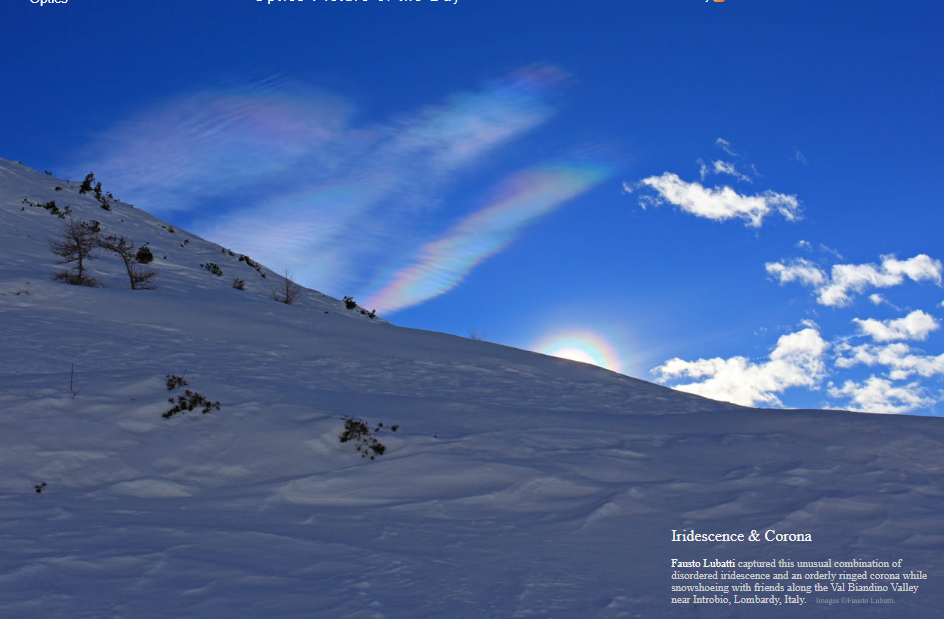OPOD - Corona & Iridescence
OPOD - Corona & Iridescence: Unveiling the Mysteries of Atmospheric Optics
Atmospheric optics never fails to amaze us with its captivating displays of natural phenomena. One such spectacle is the combination of disordered iridescence and an orderly ringed corona. Recently, Fausto Lubatti captured this extraordinary occurrence while snowshoeing with friends along the Val Biandino Valley near Introbio, Lombardy, Italy. Let's dive into the fascinating world of iridescence and corona, and unravel the science behind these breathtaking optical phenomena.
Both iridescence and corona share a common underlying cause. It all starts with water droplets in the atmosphere that individually diffract sunlight, primarily from their outer skins. These diffracted waves then combine to produce colored light that is directed in specific directions, giving rise to the captivating displays we witness.
When the water droplets are relatively uniform in size, they act in unison to form an orderly diffraction pattern in the sky. This pattern manifests as a multi-ringed corona. The rings, which are concentric circles of vibrant colors, encircle the sun or moon, creating a mesmerizing spectacle for onlookers. The uniformity in droplet size allows for a well-defined and structured corona to form.
However, when the droplets differ in size across the cloud, the resulting diffraction pattern becomes less organized. This variation gives birth to iridescence, where we observe a more chaotic and vibrant display of colors. The irregularity in droplet size leads to a scattering of light in various directions, causing the colors to appear dispersed and unordered.
It is important to note that these phenomena can be influenced by atmospheric conditions and the composition of the cloud itself. Factors such as the presence of ice crystals or the angle of sunlight can further enhance or alter the appearance of iridescence and corona.
To fully appreciate the intricacies of these atmospheric optics phenomena, it is crucial to observe them firsthand. Whether you are exploring the Val Biandino Valley or any other location with suitable atmospheric conditions, keep an eye out for these captivating displays. Here are a few tips to enhance your chances of witnessing iridescence and corona:
- Look for clouds with varying textures and densities, as these are more likely to contain droplets of different sizes.
- Position yourself so that the sun or moon is behind the cloud, allowing the light to interact with the droplets.
- Pay attention to the angle of sunlight, as this can influence the size and shape of the corona or the dispersion of colors in iridescence.
Remember, patience and keen observation are key when trying to spot these optical wonders. The ever-changing nature of clouds and atmospheric conditions means that each experience will be unique and unpredictable.
In conclusion, the combination of iridescence and corona showcases the awe-inspiring beauty and complexity of atmospheric optics. These phenomena arise from the interaction of sunlight with water droplets, resulting in stunning displays of colors and patterns. So, the next time you find yourself gazing at the sky, take a moment to appreciate the wonders that lie within our atmosphere.

Iridescence & Corona
Fausto Lubatti captured this unusual combination of disordered iridescence and an orderly ringed corona while snowshoeing with friends along the Val Biandino Valley near Introbio, Lombardy, Italy. Images ©Fausto Lubatti.

Iridescence and a corona have the same underlying cause. Water droplets individually diffract sunlight - mainly from their outer skins. The diffracted waves combine to send coloured light in particular directions.
The drops act in unison when they are more or less equally sized to form an orderly diffraction pattern in the sky - a multi-ringed corona.
The colour pattern is less orderly when the drops differ in size from point to point across the cloud - we see iridescence.

Note: this article has been automatically converted from the old site and may not appear as intended. You can find the original article here.
Reference Atmospheric Optics
If you use any of the definitions, information, or data presented on Atmospheric Optics, please copy the link or reference below to properly credit us as the reference source. Thank you!
-
<a href="https://atoptics.co.uk/blog/opod-corona-iridescence/">OPOD - Corona & Iridescence</a>
-
"OPOD - Corona & Iridescence". Atmospheric Optics. Accessed on November 26, 2024. https://atoptics.co.uk/blog/opod-corona-iridescence/.
-
"OPOD - Corona & Iridescence". Atmospheric Optics, https://atoptics.co.uk/blog/opod-corona-iridescence/. Accessed 26 November, 2024
-
OPOD - Corona & Iridescence. Atmospheric Optics. Retrieved from https://atoptics.co.uk/blog/opod-corona-iridescence/.